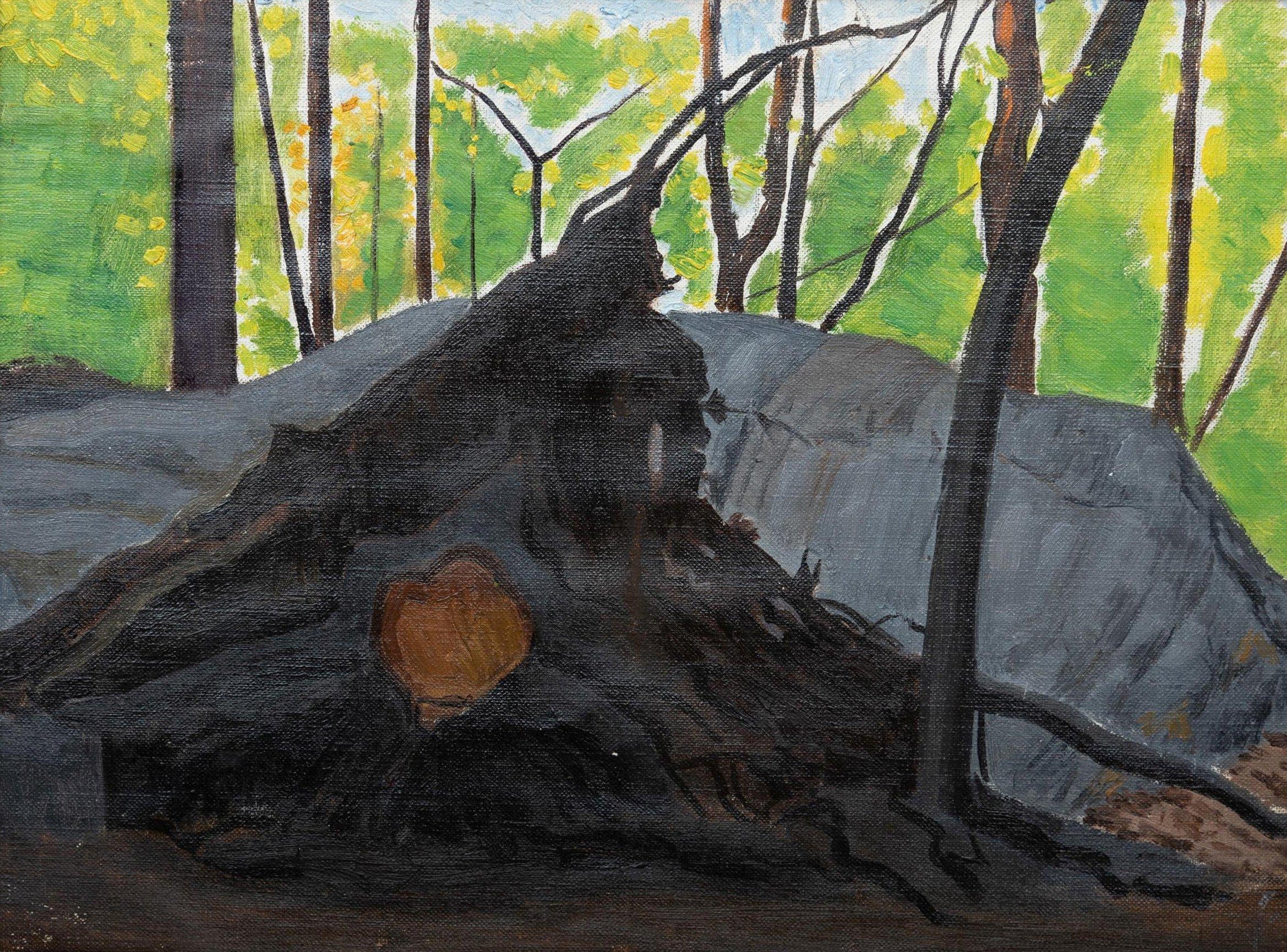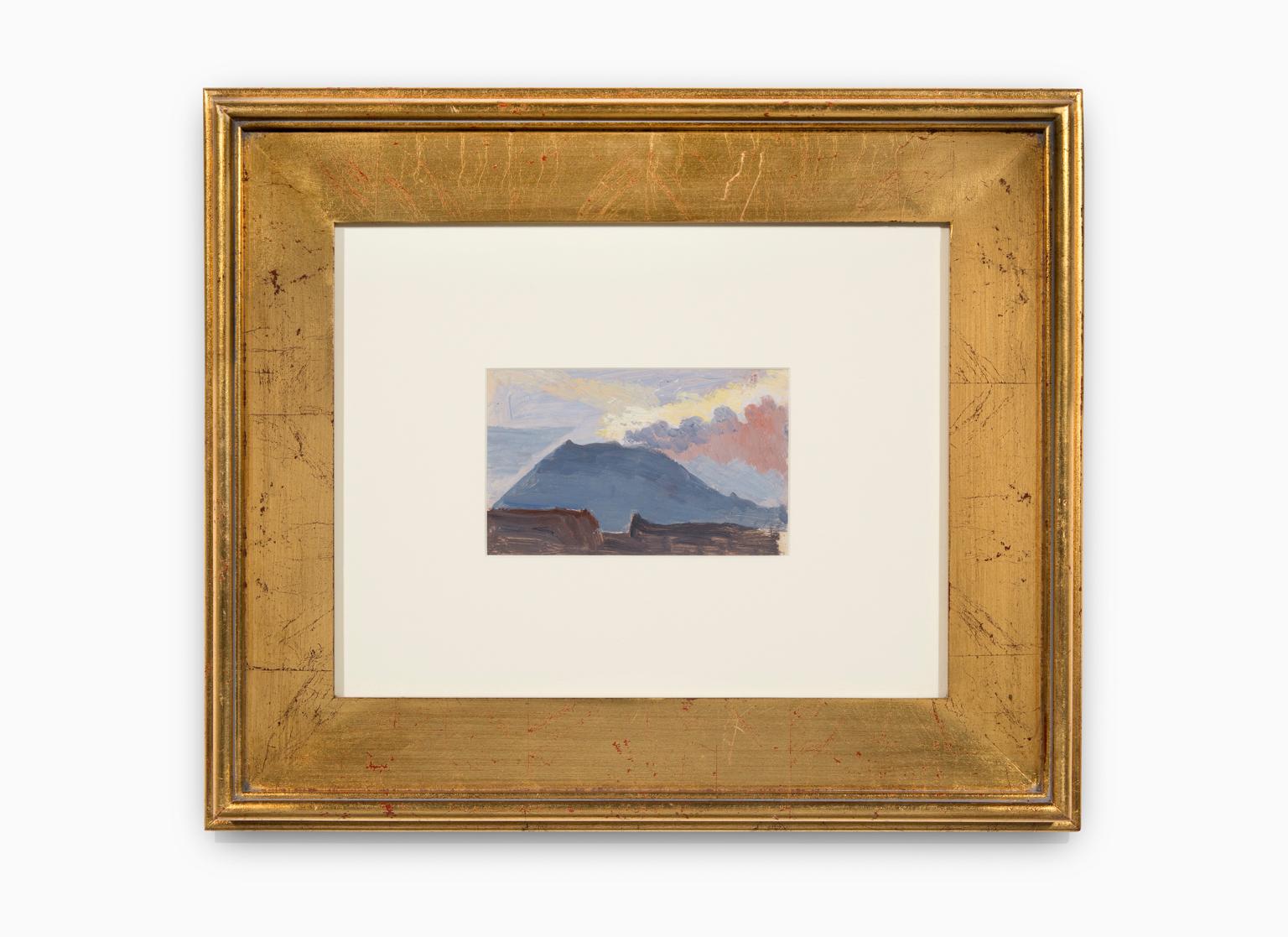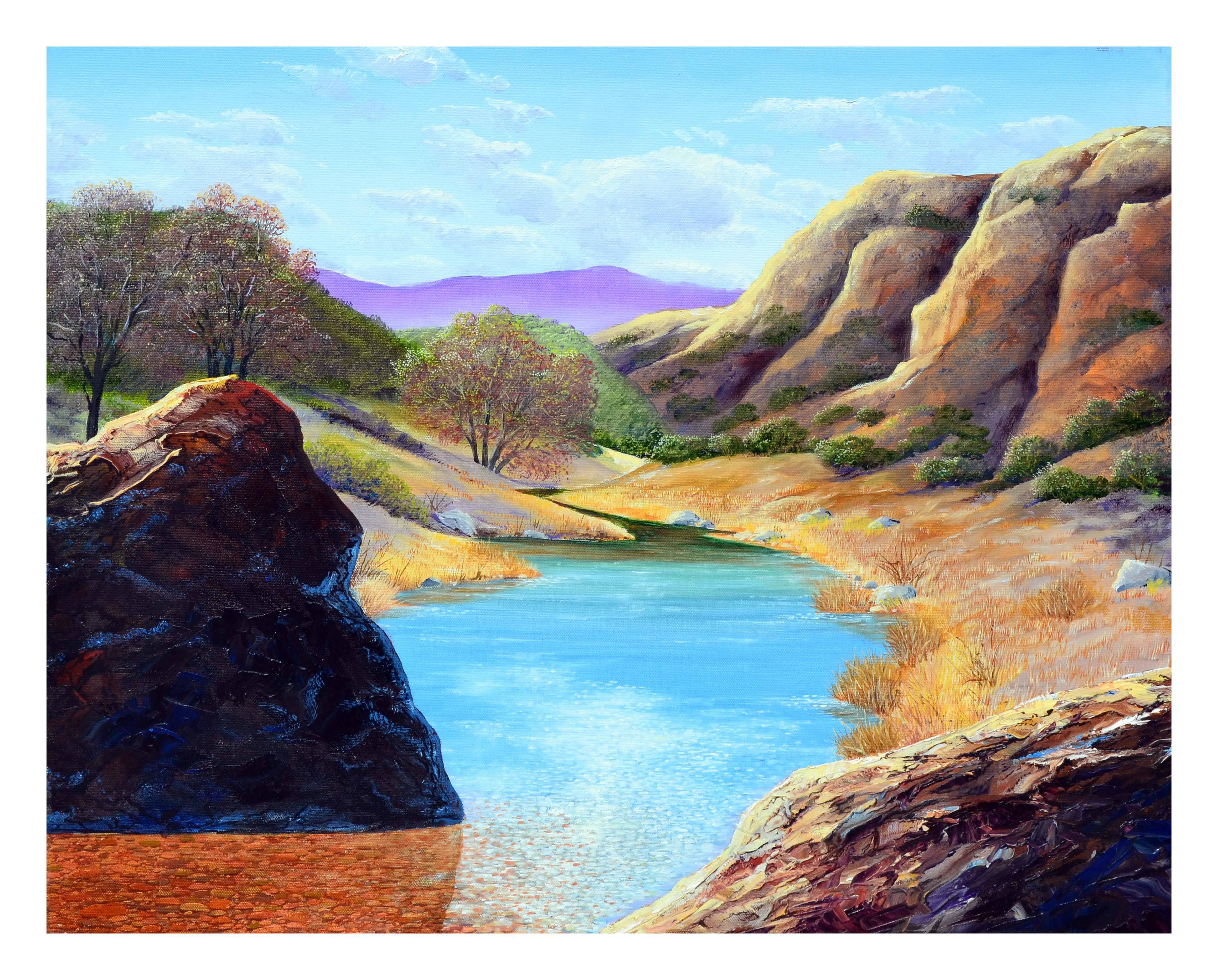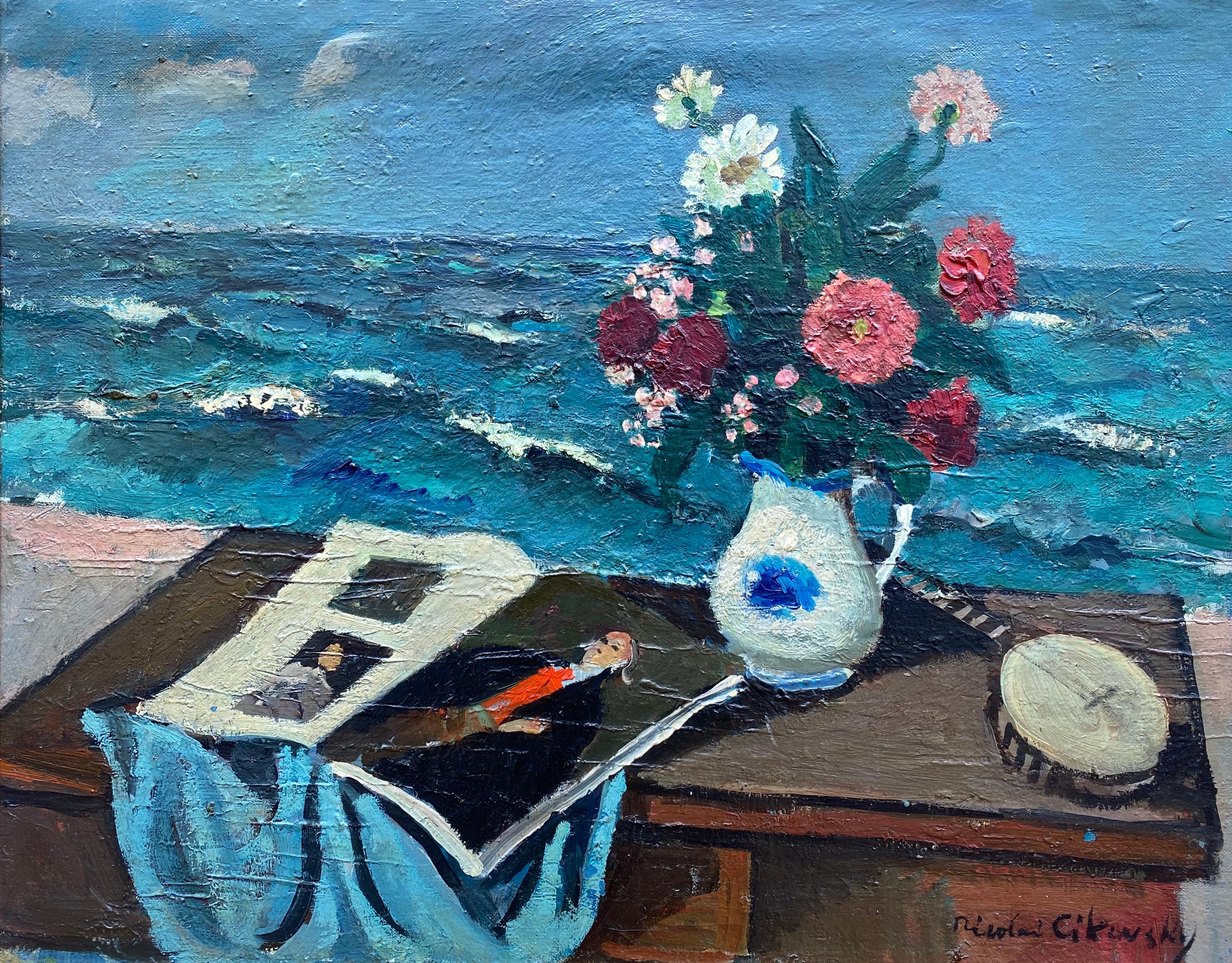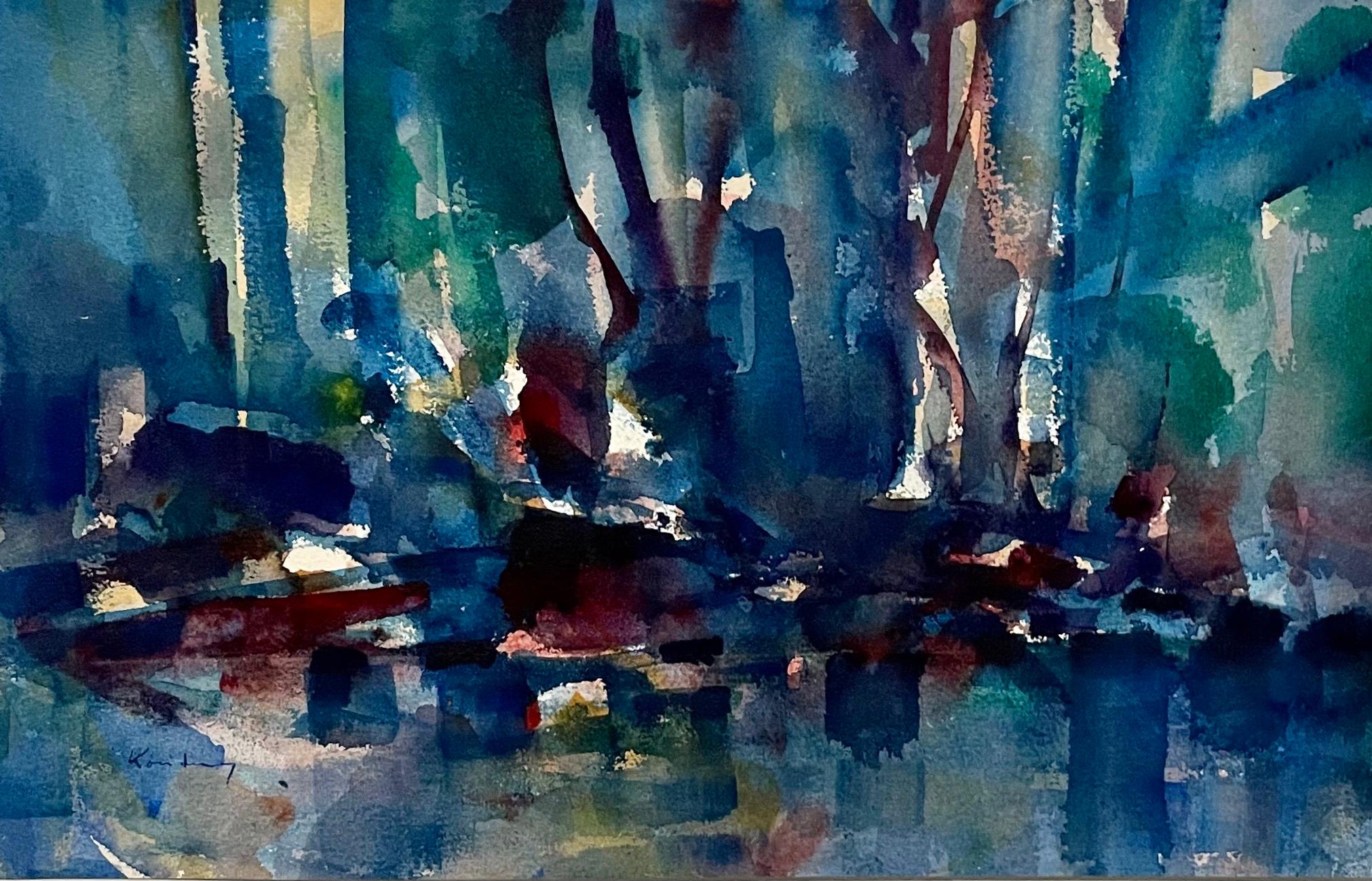William SandersonAbandoned (Colorado) - Oil on Canvas, American Modern Landscape Painting
About the Item
- Creator:William Sanderson (1905-1990)
- Dimensions:Height: 13.25 in (33.66 cm)Width: 16.5 in (41.91 cm)Depth: 0.75 in (1.91 cm)
- Medium:
- Movement & Style:
- Period:
- Framing:Frame IncludedFraming Options Available
- Condition:
- Gallery Location:Denver, CO
- Reference Number:
William Sanderson
William Sanderson, born in Dubbeln, Latvia, emigrated to the United States at the age of eighteen. He settled first in New York City where he studied at the National Academy of Design and the Art Students League. Following his studies, Sanderson worked as a book and magazine illustrator. His work appeared in several popular publications including The New Yorker, Esquire and The New Masses. In 1937, Sanderson was honored with a solo exhibition held at the Contemporary American Artist Gallery in New York City. After World War II, Sanderson relocated to Denver where he was hired by Vance Kirkland to instruct in advertising design at the University of Denver. He remained with the University from 1946 until 1972. In Colorado, Sanderson became active in the artist community, co-founding the Denver based organization known as the Fifteen Colorado Artists. Sanderson painted in a variety of styles, including Cubism, Social Realism and Hard-Edge Abstraction. His work often depicts architecture, ships, nature and the common man. In 1977, Sanderson donated a collection of forty paintings to Northeastern Junior College in Sterling, Colorado. The paintings remain on permanent display at the college in a gallery bearing his name.
- ShippingRetrieving quote...Ships From: Denver, CO
- Return PolicyA return for this item may be initiated within 7 days of delivery.
- Adobe Church, New Mexico, 1940s Modernist Southwestern Landscape Oil PaintingBy Paul Kauvar SmithLocated in Denver, COVintage 1930s - 1940s oil painting of an adobe church in New Mexico with a brilliant blue sky and clouds (likely Rancho de Taos), circa 1940. Painted by Denver modernist, Paul K...Category
1940s American Modern Landscape Paintings
MaterialsCanvas, Oil
- Colorado Mountain Summer Landscape, 1930s Framed Modernist Oil PaintingBy Arnold BlanchLocated in Denver, COVintage Modernist WPA era painting by Arnold Blanch (1896-1968) of a Colorado Landscape, likely near Colorado Springs, Colorado, with green fields, red rocks and mountains in the background under a moody sky. Dominant colors include, green, yellow, red/brown, gray, white and blue. Painting is clean and in good vintage condition - please contact us for a detailed condition report. About the Artist: Arnold Blanch was an illustrator, printmaker, teacher and painter. He was primarily known for his landscape, genre, figurative, realist, and surrealist paintings. Born in Manterville, Minnesota, he was encouraged to study art by his mother, an amateur artist. He began studying at the Minneapolis Art Institute in 1914. In 1916, he received a scholarship to study in New York at the Art Students League. In New York, he studied under Robert Henri, Francis Luis Mora, Boardman Robinson, John Sloan, and Kenneth Hayes Miller. In 1919, Blanch arrived in Woodstock, New York to study at the Art Students League summer school. He married his fellow student Lucile Lundquist, and they settled in Woodstock in 1922 after traveling to France for a year. Blanch remained in Woodstock for more than forty years, until his death. He was an important figure in the Woodstock Artists Association, as he devoted much of his time to maintaining financial and moral support for the Association. Throughout his life, Blanch had more than sixty solo and group exhibits. He was awarded the Guggenheim Foundation Fellowship in 1940. In 1962, he had a retrospective at the Krasner Gallery in New York. Blanch's artistic style changed frequently throughout his career. After the 1930's, Blanch's palette became lighter and his subjects became less serious. In the 1930s, after he and his first wife separated, Blanch became romantically involved with artist Doris Lee, and both were influenced by each other's artistic styles for the next thirty years. Blanch was also influenced by the Abstract Expressionists; however, he primarily remained a figurative painter. His last artistic style consisted of shallow pictoral space and tightly arranged structures. ©David Cook Galleries...Category
1930s American Modern Landscape Paintings
MaterialsCanvas, Oil
- Sueno del Caballo or Expressive Cranium, Southwestern Horse Skull Oil PaintingBy José García NarezoLocated in Denver, CO"Untitled (Sueno del Caballo/Cranium or Expressive Cranium)", is a oil on board by Jose Garcia Narezo (1922-1994) of a horse skull and cloth in a wi...Category
1930s American Modern Landscape Paintings
MaterialsCanvas, Oil
- Manitou, Colorado with Pikes Peak View, 1920s Mountain Landscape Oil PaintingBy Charles Ragland BunnellLocated in Denver, COOil on canvas painting by Charles Ragland Bunnell (1897-1968) circa 1928-1929 of a Manitou, Colorado with a view of Pikes Peak. Early 20th century mountain landscape painting. Presen...Category
1920s American Modern Landscape Paintings
MaterialsCanvas, Oil
- American Modernist Abstract Landscape Oil Painting of Trees, Yellow Orange BlueLocated in Denver, COMid 20th Century abstracted landscape pen and oil painting with trees by American Modernist Henriette "Yetti" Stolz, signed on the back of the painting. Portrays a modernist landscape of a forest with trees, painted in shades of gold, brown, orange, and blue. Presented in a vintage frame measuring 30 ¾ x 36 ¼ inches. Image measures 30 ¼ x 35 ¾ inches. Provenance: Estate of the Artist, Henriette "Yetti" Stolz Painting is in good condition - please contact us for a detailed condition report. About the Artist: Henriette “Yetti” Stolz was born in Serbia in 1935 ( and is still living ). Her family emigrated to Denver, Colorado, in the early 1950s after WWII and she attended East High School before studying art at Colorado College, in Colorado Springs in the mid to late 50s. While there studying she would have been exposed to modernist artists working both at the college ( ie. Mary Chenoweth...Category
Mid-20th Century American Modern Abstract Paintings
MaterialsCanvas, Ink, Oil
- Early Spring, 1930s Impressionist Style Oil Painting, The Artists StudioBy John Edward ThompsonLocated in Denver, COOil on canvas painting, titled 'Early Spring' (Thompson's Studio) painted in 1933 and signed by John Edward Thompson (1882-1945). Impressionist style portrayal of the artists studio ...Category
1930s American Modern Landscape Paintings
MaterialsCanvas, Oil
- "Tree, Trunk, and Roots, New York" Joseph Stella, American ModernismBy Joseph StellaLocated in New York, NYJoseph Stella (1877 - 1946) Tree, Trunk, and Roots, Bronx, New York, circa 1924 Oil on canvas 12 x 16 inches inscribed in another hand Joseph Stella/Estate and bears Joseph Stella Estate stamp (on the reverse) Provenance: The Estate of the Artist Rabin & Kreuger, New Jersey Parke Bernet Galleries, New York, March 14, 1968, Lot 147 ACA Galleries, New York Thence by descent Stella was born June 13, 1877 at Muro Lucano, Italy, a mountain village not far from Naples. He became painter laureate of Muro Lucano when he was in his teens with a representation of the local saint in the village church. Stella immigrated to America in 1896 and studied medicine and pharmacology, but upon the advice of artist friend Carlo de Fornaro, who recognized his undeveloped talent, he enrolled at the Art Students League in 1897. Stella objected to the rule forbidding the painting of flowers, an indication of his lifelong devotion to flower painting. He also studied under William Merritt Chase in the New York School of Art and at Shinnecock Hills, Long Island in 1901-1902, displaying the bravura brushwork and dark Impressionist influence of Chase. Stella liked to paint the raw street life of immigrant society, rendering this element more emotionally than the city realists, the Aschcan School headed by Robert Henri. Stella went through a progression of styles--from realism to abstraction--mixing media and painting simultaneously in different manners, reviving styles and subjects years later. The "Survey" sent Stella to illustrate the mining disaster of 1907 in Monongah, West Virginia, and in 1908 commissioned him to execute drawings of the Pittsburgh industrial scene. Steel and electricity became a major experience in shaping his responses to the modern world, and Stella succeeded in portraying the pathos of the steelworkers and the Pittsburgh landscape. Stella went abroad in 1909 at the age of thirty-two, lonely for his native land. He returned to Italy, traveling to Venice, Florence and Rome. He took up the glazing technique of the old Venetian masters to get warmth, transparency, and depth of color. One of Stella's paintings was shown in the International Exhibition in Rome in 1910 and was acquired by the city of Rome. The influence of the French Modernists awakened his dormant individuality. His friendship with Antonio Mancini, a Futurist, also played a role in his new style. At the urging of Walter Pach...Category
1920s American Modern Landscape Paintings
MaterialsCanvas, Oil
- "Study of Mt. Vesuvius" Oil on Canvas, Blue Tones, LandscapeBy Joseph StellaLocated in Detroit, MISALE ONE WEEK ONLY “Study of Mt. Vesuvius" is a small intimate painting of an active volcano that has at times wrecked great destruction. As seen from a distance, it is a calm blue ...Category
Late 20th Century American Modern Landscape Paintings
MaterialsCanvas, Oil
- Mount Hamilton Realist LandscapeBy Luke StamosLocated in Soquel, CAVivid, modernist Mt. Hamilton landscape attributed to Luke Stamos (American, 20th century). Oil on canvas. Unsigned. Unframed. Image size: 18"H x 24"W. This art work is in the distinctive realistic style of Luke Stamos. We certify that the work is by the hand of Luke Stamos. Artists statement: "I was born in Chicago, and began studying art at the Chicago Art Institute at age 5. When my family moved to San Francisco in 1944, I became aware of California’s splendid outdoor life, and began to pursue a life-long hobby of hunting and fishing. While attending high school in Daly City...Category
1980s American Modern Landscape Paintings
MaterialsCanvas, Oil
- "Garden Splendor"By Nicolai CikovskyLocated in Southampton, NYOil on canvas painting by the Russian/American artist, Nicolai Cikovsky. Signed lower left. In good unrestored condition. Housed in custom made wood and lemon gold gilt frame. Overal...Category
1940s American Modern Landscape Paintings
MaterialsCanvas, Oil
- “Bouquet by the Sea”By Nicolai CikovskyLocated in Southampton, NYOil on artist board original painting by the well known American artist, Nicolai Cikovsky. Thick vibrant colors with a vase of flowers, a banjo and a notebook with photographs with a rough sea as the background. Circa 1940. Condition is very good. Overall framed in a circa 1960 frame, 23 by 27.25 inches. Landscape and figure painter Nicolai S. Cikovsky, 1894-1984, was born in Russia, where he studied at the Vilna Art School, 1910-1914; the Penza Royal Art School, 1914-1918; and Moscow High Tech Art...Category
1940s American Modern Landscape Paintings
MaterialsCanvas, Oil
- Modernist Abstract Expressionist Watercolor Painting Bauhaus Weimar Pawel KontnyBy Pawel KontnyLocated in Surfside, FLAbstract watercolor composition bearing the influence of the earlier color-block compositions of Paul Klee. Pawel August Kontny, (Polish-German-American artist) He was born in Laurahuette, Poland, in 1923, the son of a wealthy pastry shop owner. In 1939 he began studying architecture in Breslau where he was introduced to the European masters and to the work of some of the German Expressionists, soon afterward banned as "degenerate artists" and removed from museums throughout Germany by the Nazi regime. His studies were interrupted by World War II. Drafted into the German army, traveling in many countries as a soldier, he sketched various landscapes but in 1945, he was captured and held as a prisoner of war in Italy. After the war, he studied at the Union of Nuremberg Architects to help design buildings to replace ones destroyed in the war. He recorded his impressions of the local population and the landscapes through his watercolors and drawings. Pawel Kontny thereafter moved to Nuremberg, Germany, becoming a member of the Union of Nuremberg Architects and helping to rebuild the city's historic center. He soon decided to concentrate on his professional art career. He married Irmgard Laurer, a dancer with the Nuremberg Opera. Pavel Kontny 's career as an artist was launched with his participation in an all German exhibition, held at the Dusseldorf Museum in 1952. He held one-man shows in Germany, Switzerland and the United States. During his trip to the United States in 1960, Kontny became instantly enamored with Colorado, and decided to relocate to Cherry Hills with his wife and two children. He quickly established himself in the local art community, being affiliated for a time with Denver Art Galleries and Saks Galleries. His subject matter became the Southwest. During this time he received the Prestigious Gold Medal of the Art Academy of Rome. His extensive travel provided material for the paintings he did using his hallmark marble dust technique. he also worked equally in pastel, watercolor, charcoal and pencil-and-ink. in a style which merged abstraction and realist styles, influenced by Abstract Expressionist painting and South Western American landscapes. In the early 1960s he was one of only a few European-born professional artists in the state, a select group that included Herbert Bayer (1900-1985), a member of the prewar Bauhaus in Weimar and Dessau, Germany, and Roland Detre (1903-2001), a Hungarian modernist painter. As a Denver, Colorado resident, Pavel Kontny exhibited at galleries and museums throughout the United States, Germany and Japan. There, he was inspired by frequent trips to Native American pueblos in the Southwest, as well as by the study of the Plains Indians of Montana and Wyoming. Over the years Kontny had a number of students and generously helped young artist by hosting exhibitions at his Cherry Hills home. For many years he generously donated his paintings to support charitable causes in Denver. Influences during his European years included German pastelist C.O. Muller, German Informel painter Karl Dahmen and Swiss artist, Hans Erni. In the early 1950s his painting style showed the influence of the Die Brücke (The Bridge), a group of German expressionist artists formed in Dresden in 1905 who had a major impact on the evolution of modern art in the twentieth century in Germany. By the middle of the decade his style incorporated more referential abstraction and total abstraction, resulting in part from his study of Hans Hartung, a German artist based in Paris who exhibited his gestural abstract work in Germany. The American moon landing in 1969 inspired Paul Kontny...Category
20th Century American Modern Landscape Paintings
MaterialsCanvas, Oil
